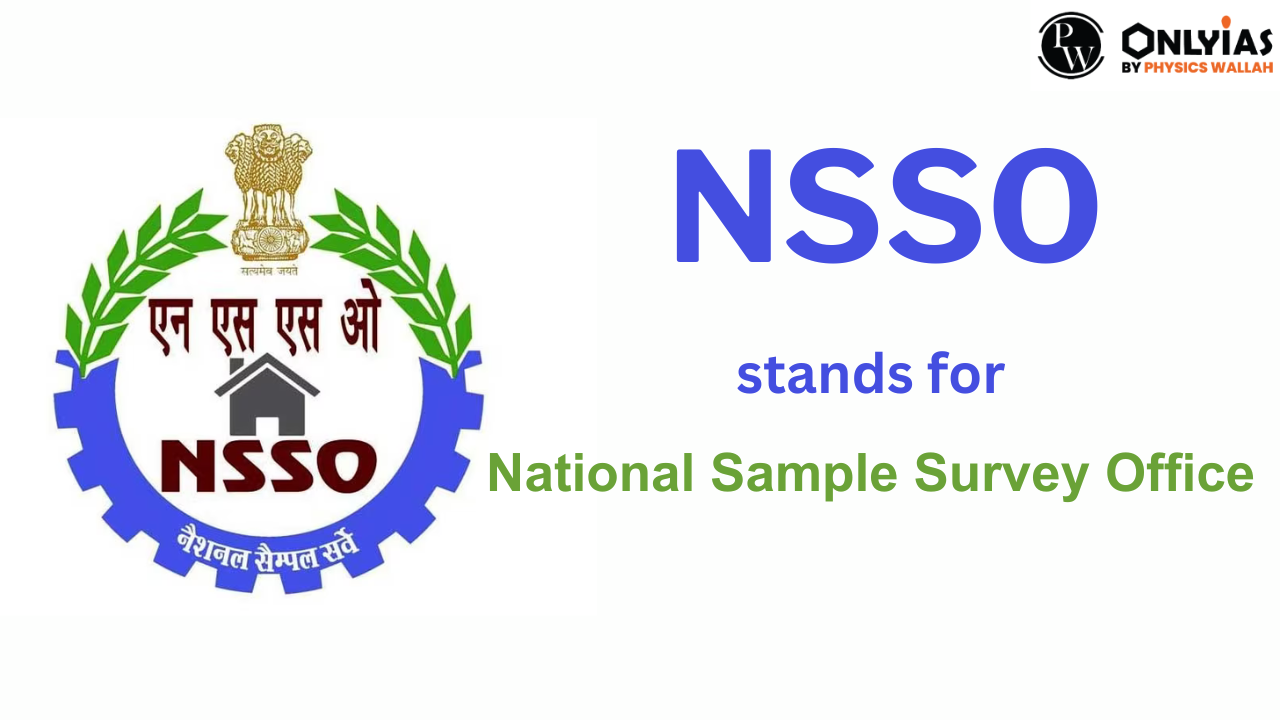![]() Ananya Gupta
Ananya Gupta
![]() August 26, 2023 06:48
August 26, 2023 06:48
![]() 5874
5874
![]() 0
0
The full form of NSSO is National Sample Survey Organization, is an essential institution in India for gathering socio-economic data. Discover its role in policy-making, economic planning, and its significance in UPSC exams. Explore the significance of NSSO's insights in shaping informed decisions for the nation's progress.

The National Sample Survey Office (NSSO), known as NSSO, was established under the Ministry of Statistics in 1950. It was founded with the primary goal of conducting comprehensive surveys across diverse socio-economic groups to gain insights into various facets of the nation’s growth and development. NSSO’s surveys follow a methodical approach, spanning from six months to over a year, to gather valuable data.
These objective surveys play a pivotal role in shaping policies and decisions. Notably, on 23rd May 2019, NSSO transformed into the National Statistical Office (NSO) following its merger with the Central Statistical Office (CSO). This amalgamation was aimed at enhancing coordination between the two entities. The NSO is overseen by the Ministry of Statistics and Program Implementation (MOSPI). Aspiring candidates preparing for exams such as the IAS will find pertinent insights into these organizations, fostering a deep understanding of NSSO’s significance for upcoming examinations.
The National Sample Survey Office (NSSO), now known as the National Statistical Office (NSO), is a prominent statistical organization in India. It was established under the Ministry of Statistics and Program Implementation (MOSPI) in 1950. The primary objective of NSSO is to collect and analyze data related to various aspects of the economy and society through nationwide surveys.
NSSO conducts surveys that cover a wide range of topics, including employment, education, health, consumption patterns, income distribution, poverty, and more. These surveys involve collecting data from a representative sample of households and individuals across different socio-economic groups. The data collected from these surveys is used to assess the socio-economic condition of the population, monitor trends over time, and inform policymaking and planning.
The surveys conducted by NSSO provide valuable insights into the living standards, economic activities, and overall development of the country. The organization’s data is widely used by government agencies, researchers, policymakers, and various stakeholders to formulate policies, design programs, and make informed decisions.
In 2019, NSSO was restructured and re-designated as the National Statistical Office (NSO) to reflect its expanded role in statistical activities beyond sample surveys. The NSO continues to be a crucial institution for generating reliable and comprehensive statistical information that contributes to India’s socio-economic progress.
NSO stands for “National Statistical Office.” It is an organization in India responsible for conducting comprehensive statistical activities, including collecting, analyzing, and presenting data on various socio-economic aspects of the country. The NSO plays a crucial role in providing accurate and reliable statistical information that informs policy decisions, economic planning, and development strategies.
| Full Form of NSSO, CSO,NSO | |
|---|---|
| NSSO Full Form | National Sample Survey Office |
| CSO Full Form | Central Statistical Organization |
| NSO Full Form | National Statistical Office |
| Year of NSSO-CSO Merger | 2019 |
The merger of the National Sample Survey Office (NSSO) and the Central Statistical Office (CSO) was a significant administrative change aimed at streamlining and enhancing the statistical activities and functions of these two organizations in India. Here are the key details about the NSSO and CSO merger:
Merger Details:
Objective of the Merger:
Rationale:
Expanded Scope of NSO:
Impact:
The merger of NSSO and CSO into the National Statistical Office reflects India’s commitment to modernizing its statistical infrastructure, ensuring consistency and reliability in data, and facilitating evidence-based policy formulation and planning.
The National Sample Survey Office (NSSO), now known as the National Statistical Office (NSO), comprises four divisions responsible for various aspects of statistical data collection, analysis, and dissemination. While the structure may have evolved over time, here are four major divisions that were present in NSSO:
1. Survey Design and Research Division (SDRD):
2. Data Processing Division (DPD):
3. Co-ordination & Publication Division (CPD):
4. Field Operations Division (FOD):
The Central Statistical Organization (CSO) is a prominent statistical agency in India that plays a vital role in collecting, compiling, and analyzing statistical data related to various aspects of the economy and society. The CSO operates under the Ministry of Statistics and Programme Implementation (MOSPI) and is responsible for providing accurate and reliable statistical information to support informed decision-making and policy formulation.
The CSO’s primary functions include:
The National Statistical Office (NSO) is an important organization in India that deals with collecting and understanding different kinds of information. It came into existence when two other organizations, the National Sample Survey Office (NSSO) and the Central Statistical Office (CSO), joined together. Even though the government didn’t specifically talk about NSO’s exact role, it’s now the name used for both of these organizations.
The NSO is part of the Ministry of Statistics and Program Implementation. The leader of this ministry, called the Secretary, oversees the NSO. The merging of NSSO and CSO didn’t change how the National Statistical Commission (NSC) works. The NSC is the group that looks after all the activities related to gathering and analyzing data in the country.
The coming together of NSSO and CSO means some changes, like NSSO now working under the Ministry of Statistics and Program Implementation. This change might affect how independent data collection and sharing are. But the main goal of this merger is to make sure that the information collected is accurate and can be used by the government to create better policies and plans for the country.
In simple terms, the NSO is like a big information hub that brings together data from different places, so the government can make good decisions based on reliable facts.
<div class="new-fform">
</div>

Latest Comments